1:48 Arii F4U-1A Corsair, Kepford’s “White 29”
Here's my rendition of the Arii (originally produced by Otaki?) 1:48 scale F4U-1A Corsair. Even though it's well over thirty years old, the Arii kit builds into a nice Corsair. The good points are very accurate outline and shapes, finely recessed panel lines, and great parts fit. Drawbacks are a simple and inacurate cockpit and wheels, and an engine that doesen't remotely resemble any engine used in any aircraft. Here's how I upgraded the kit: I replaced the cartoonish engine with with a resin R-2800, updated the cockpit with Eduard photoetched insturment panel, seat and sidewall details, and used seatbelts and wheels from True Details. I replaced ther kit tail wheel with a more accurate-looking one from the spares box, and attached it at an angle for a more candid appearance. I also cut away the flaps and dropped them, added exhaust stacks made from drilled-out styrene rod, and added a small whip antenna to the fuselage spine. I couldn't determine if this plane had the tail hook removed or not, so I left it on.
VF-17's Corsairs didn't have the usual antenna mast, and some had unusual field-modified antennas. Based on photos, I built an antenna that runs fron the top if the vertical fin down to the tip of the right horizontal stabilizer. From there, it runs into the usual antenna lead-in on the right side of the fuselage, behind the cockpit. I don't know for certain if it's accurate, but that's how I interpreted the antenna arrangment in photos.
I used a Pasche VL airbrush to apply the three-toned camouflage scheme, though most photos of the actual aircraft indicate it was very weathered, with almost no distiction between the non-specular sea blue upper surfaces and the intermidiate blue sides.
For markings, I used a SuperScale sheet to portray "White 29", the plane flown by Lt. Ira Kepford of VF-17 while based at Ondonga, New Georgia, in the Solomon Islands in late 1943. I made a mistake in not placing the kill markings at the correct angle to the tape covering the seams of the forward fuselage cell.
VF-17 was the first navy squadron to be equipped with the Corsair. Assigned briefly to USS Bunker Hill, the squadron was soon transferred to the Solomon Islands to serve as a land-based squadron. In its two tours of duty in the Solomons, VF-17 was credited 156 aerial victories and produced 12 aces, the most of any squadron in the Navy. Kepford was the U.S. Navy's 6th highest ranking ace with 16 victories and 8 probables.


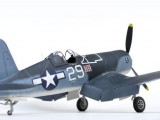
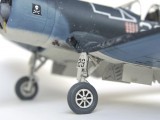
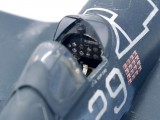
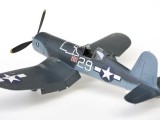
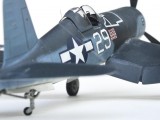
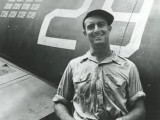

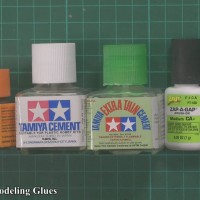
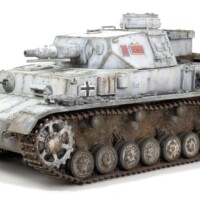

Great looking Kepford Corsair! Well done!
Thanks, Morne!
Hi Drew; Having built one of these about 30 years ago, I agree with your comments, but I must add what a seriously good model you have there. You've gone to a lot of trouble & your results are worth it!
Thank you, Tony - I appreciate the comments!
Nicely finished and photographed, sir...I like it a lot - 🙂
Thanks, Craig!
Well done Drew. Your extra work and detail has really paid off.
Thank you Terry!
Congratulations Drew, it's perfect built of a fantastic plane. It seems reality.
Thanks, Christian!
Great looking Corsair.
Thanks, Rob!
Nice old Kit rejuvenated and BUILD
P.k
Thank you, P.k.!
Very convincing, Drew, However good they may be, I've seen too many WWII fighter plane models, but this one is an exception.
Thanks, George - I really appreciate the kind words!
Nice work Drew, a very fine build of an outstanding plane.
Well done sir.
Thank you, Simon!
Hello Drew...Congratulations on a fine build of a rather basic kit. Nice attention to detail, paint and markings. I think the antenna arrangement looks good for Kepford's Corsair. As for the tail hook, you could have gone in either direction as VF-17 did remove them for island operations and installed them to fly CAP over the fleet. Your model looks very good.
Thanks, Jim! Comments from an acknowleged Corsair authority like yourself means a lot.
That's a good-lookin' Corsair! I'm working on 2 1/72 scale birds right now (both old Hasegawa kits). These older kits still clean up into nice looking builds with treated with a little TLC (and an occasional aftermarket part or two!).
Great work!
Thank you, Greg!
superb piece of work
Thanks, Bob!
Drew, wonderful job on the old bird. Yes, Otaki, then Arii, and at some point, Ertl.
Agree good basis for a U-bird, with the shortcomings in the engine and cockpit.
How did you drop the flaps?
Hi, Bernard, thanks for your comments! I dropped the flaps by cutting them from the wings with an X-acto knife, and filing the edges of the pieces smooth. After gluing the flap pieces together, I took sections of the kit sprue trees, cut them to match the length of the flap pieces, then glued them to the gap. For the short section of curved flap, I used pliers to bend the sprue to fit. I then cut sheet styrene to shape to close the gaps on the ends of each flap piece, then glued them in place. Once in place I cut triangular pieces of very thin plastic sheet to form the wedge-shaped spacers between the flaps. My explanation makes it sound a lot more difficult than it really is. I did the same thing for a Hasegawa F4U-4, and it's a fairly simple job.
Nice build and great details.
Thanks Bryan!
🙂 ... Greetings ... 🙂 :
I am very much having a good time seeing this model.
You have done a very good work here, the paint scheme is such a pleasure to admire.
This model ( include the fact that it is a mount of Ira Kepford, makes my search for the 1/32 scale by REVELL ) even more stronger.
I am still watching it, thanks for the photos.
Thanks, and I appreciate your comments!
Beautiful build!
Thanks, David!
The Otaki Corsair is actually 43 years old, having first appeared in 1972 (which makes its quality even more astounding). The only additional item I would have considered for the kit would be the True Details cockpit, which is done for this kit and really improves things. The nice thing is these kits are now cheap enough that even with all the add-on aftermarket stuff, they're still less expensive than the current price for the Tamiya kit (which admittedly has everything you need right in the box).
A couple historical notes: VF-12 was actually the first F4U squadron, but they never solved the "coming aboard" problems of the early F4U-1 and transferred to the F6F-3 before they went aboard Saratoga in the summer of 1943. VF-17 was the second squadron, but the first to figure out how to cure the Corsair's problems with carrier decks. At the time of finishing their tour in Febvruary 1944, they were the top-scoring squadron and top number of aces, but then VF-9 finished their tour on the Essex at #1 in both categories in March 1944, to be beaten by VF-15 with 27 aces and 318 aerial victories, while VF-2 came in #2 for victories and #1 for number of aces with 28.
A lot of folks don't know, this is actually Kepford's second Corsair. He got back from the mission that gave him nightmares the rest of his life (Nov 11, 1943 - the mission to defend the carriers during the Rabaul raid) and that airplane was pretty much shot-up so he got this one.
This is BTW a very nice rendition of his airplane.
Thanks for your always insightful clarifications and corrections, Tom. My cursory research indicated VF-17 was the first F4U squadron, and I appreciate you setting it straight
.
Tom, madre de dios! It's been out that long? Boy, am I old!
i have always been a fan of the Corsair... this one is a beauty! great work and beautiful finish!
Thanks very much, Ramon!
Excellent job on an old but good kit, Drew.
Great presentation as well, good job !
Thank you, Bernd! I appreciate your comments. Your F6F Hellcat is a work of art!
A nice job but it is way too "clean" and lacking in paint chips and abrasion. The South Pacific crushed coral beaches were brutal on the paint.
https://c1.staticflickr.com/1/828/26874090227_a678c1fcbc_o.jpg